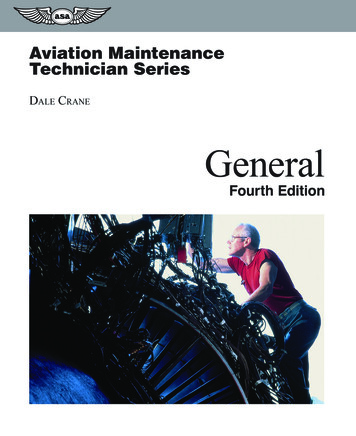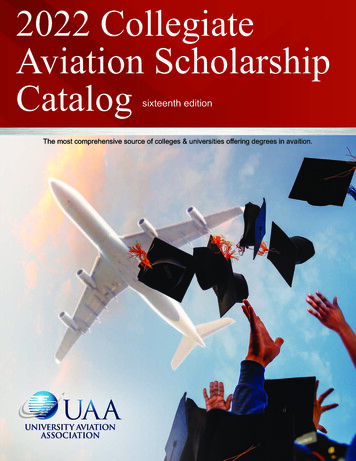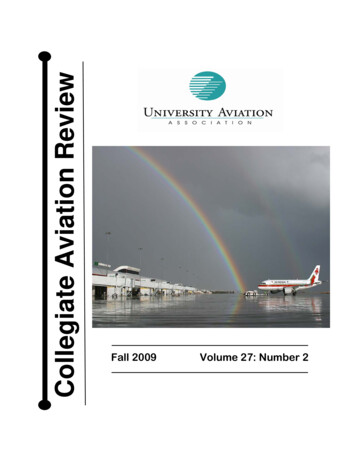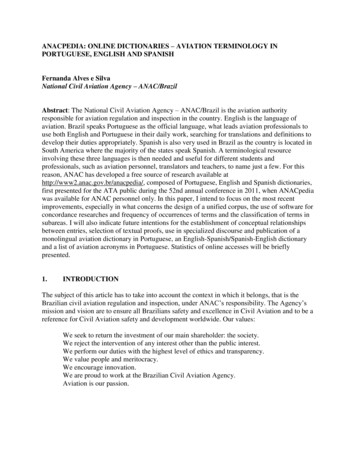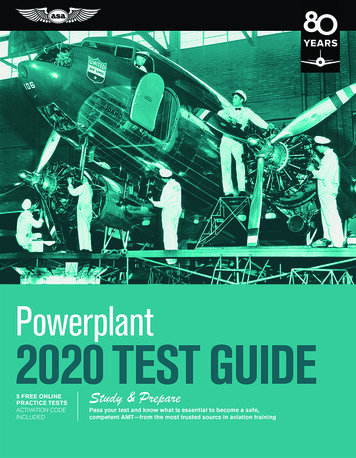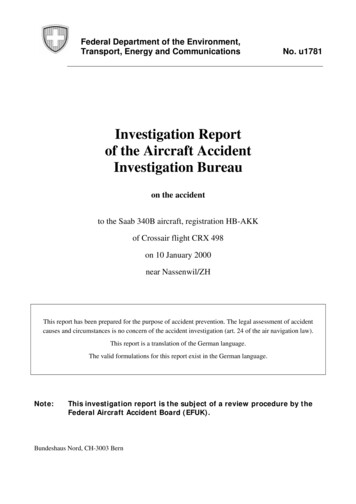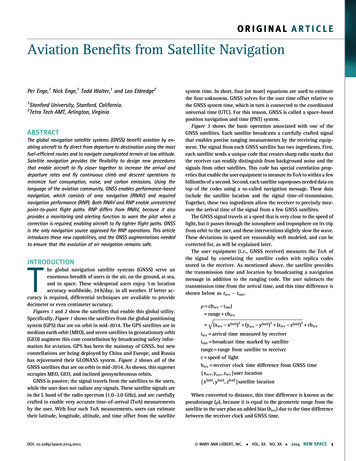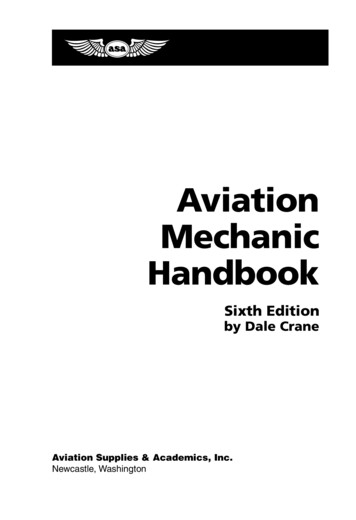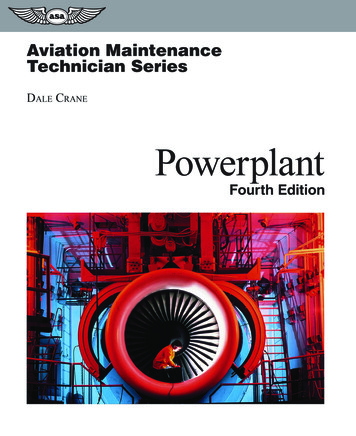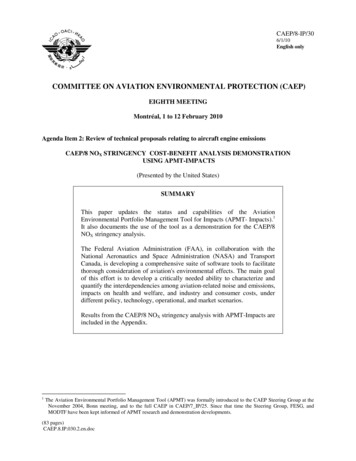
Transcription
CAEP/8-IP/306/1/10English onlyCOMMITTEE ON AVIATION ENVIRONMENTAL PROTECTION (CAEP)EIGHTH MEETINGMontréal, 1 to 12 February 2010Agenda Item 2: Review of technical proposals relating to aircraft engine emissionsCAEP/8 NOX STRINGENCY COST-BENEFIT ANALYSIS DEMONSTRATIONUSING APMT-IMPACTS(Presented by the United States)SUMMARYThis paper updates the status and capabilities of the AviationEnvironmental Portfolio Management Tool for Impacts (APMT- Impacts).1It also documents the use of the tool as a demonstration for the CAEP/8NOX stringency analysis.The Federal Aviation Administration (FAA), in collaboration with theNational Aeronautics and Space Administration (NASA) and TransportCanada, is developing a comprehensive suite of software tools to facilitatethorough consideration of aviation's environmental effects. The main goalof this effort is to develop a critically needed ability to characterize andquantify the interdependencies among aviation-related noise and emissions,impacts on health and welfare, and industry and consumer costs, underdifferent policy, technology, operational, and market scenarios.Results from the CAEP/8 NOX stringency analysis with APMT-Impacts areincluded in the Appendix.1The Aviation Environmental Portfolio Management Tool (APMT) was formally introduced to the CAEP Steering Group at theNovember 2004, Bonn meeting, and to the full CAEP in CAEP/7 IP/25. Since that time the Steering Group, FESG, andMODTF have been kept informed of APMT research and demonstration developments.(83 pages)CAEP.8.IP.030.2.en.doc
-2-CAEP/8-IP/301.INTRODUCTION1.1In the past, modeling tools that supported CAEP generated either noise or emissionsoutputs, against which policy costs were calculated. CAEP considered the cost to implement a policyagainst a single environmental performance indicator (e.g., number of people impacted by noise). Withthe advent of the work on common databases and inputs, CAEP initiated a process to jointly considernoise, surface air quality, climate change, fuel burn, plus industry and consumer cost interdependencies.The Federal Aviation Administration (FAA), in collaboration with Transport Canada and the NationalAeronautics and Space Administration (NASA), has developed a comprehensive suite of software tools tofacilitate thorough consideration of aviation's environmental effects. The main goal of this effort has beento create a critically needed ability to characterize and quantify the interdependencies amongaviation-related noise and emissions, impacts on health and welfare, and industry and consumer costs,under different policy, technology, operational, and market scenarios. The component of the tools suitethat estimates the environmental impacts of aircraft operations through changes in health and welfareendpoints for climate, air quality and noise is entitled the Aviation Environmental Portfolio ManagementTool for Impacts (APMT-Impacts).2 Beginning in 2004, information on APMT has been submitted toCAEP and stakeholders, including the initial APMT requirements and architecture studies andprototyping plan.3 APMT Progress was last reported to the CAEP in February 2007, in CAEP/7 IP/25.1.2At CAEP/7, transitioning to a more comprehensive approach for assessing and addressingaviation environmental impacts was considered, as documented in CAEP/7-WP/68, Para 4.14. TheCAEP/7 report notes that “to fully assess interdependencies and analyses of the human health andwelfare impacts, CAEP would need to: (1) employ tools that (are) capable of looking (at multiple)environmental parameters; (2) frame the impacts of these parameters on common terms, so that it canunderstand the implications of the interdependencies . Following the discussion, the meeting:a) acknowledged the growing complexity associated with assessing noise and emissionseffects of aviation, especially when considering impacts and their influence onbenefits-costs, as well as the case for CAEP to get a better understanding of theseimpacts and the benefits of environmental mitigation based on establishing the valueof such reductions in addressing the stated problem ;b) endorsed the consideration of a transition to a more comprehensive approach toassessing actions proposed for consideration by CAEP/8;c) specified that traditional cost-effectiveness analyses of policy scenarios requiringeconomic analysis be provided for CAEP/8, but that environmental impacts and costbenefit information and analyses also be provided in the form of a sample problemwhich may enable CAEP/8 to put the new information into context, and to furtherconsider how to integrate environmental impacts and interdependencies informationinto its decision-making; andd) note that the tool suite under development by the United States and Canada isintended to have the capability to enable implementation of this more comprehensiveapproach in a manner that is consistent with the interdependencies frameworkestablished for the CAEP/8 work programme.”23APMT-Impacts was formerly named the APMT Benefits Valuation Block (BVB)Requirements Document for the APMT. Ian Waitz, et al. June 2006. (Report No. tecture Study for the APMT. Ian Waitz, et al. June 2006. (Report No. tner/reports/apmt-arch-rpt2006-002.pdf;Prototype Work Plan for the APMT. Ian Waitz, et al. June 2006. (Report No. tner/reports/apmt-prototype-rpt2006-003.pdf
-3-CAEP/8-IP/301.3This paper serves to update CAEP on the progress and capabilities of APMT-Impacts.The paper also fulfils task MOD.07, going beyond the traditional cost-effectiveness analysis to provideenvironmental impacts and cost-benefit information for the CAEP/8 NOX stringency analysis.2.FESG – MODTF ANALYSIS2.1CAEP tasked the Forecasting and Economic Support Group (FESG) and Modelling andDatabase Task Force (MODTF) to conduct an analysis of stringency scenarios to reduce emissions ofnitrogen oxides (NOX) relative to the ICAO CAEP/6 Standard as an element of the CAEP/8 workprogramme. Ten stringency options were analysed for two potential implementation years, 2012 and2016, with potential changes ranging from between 5% and 20% compared to the current Standards. Theanalysis was based on an assessment of the changes in emissions inventories and costs that would resultfrom modifying, where appropriate, the existing in-production engines to meet the range of scenarios.For the analysis, MODTF assessed emissions reductions and potential environmental trade-offs for thescenarios. FESG established the costs assumptions and assessed overall cost-effectiveness of thestringencies. The final cost-effectiveness results were presented as costs per tonne of NOX reduction forthe ICAO Landing Take-Off (LTO) cycle in a joint MODTF-FESG paper to CAEP/8 (WP015).2.2Noting that the large engines dominate the NOX reductions calculated by the analysis, thejoint MODTF-FESG effort concluded that (1) the cost per tonne NOX reduced is lowest for stringencyscenarios #1 through #5, (2) the cost increases by a factor of three to four for scenarios #6 and #7, and (3)the cost further doubles for scenarios #8 through #10.3.POLICY ANALYSIS APPROACHES3.1Regulatory agencies in many world regions use economic analysis to guide policydecisions through an explicit accounting of the costs and benefits associated with a regulatory change.Economic policy evaluation approaches commonly used in policy assessments include cost-benefit, costeffectiveness and distributional analyses. Cost-effectiveness analysis (CEA) is meant to be used forevaluating policies with very similar expected benefits; a policy that achieves the expected benefits withthe least costs is the preferred policy.4 A cost-benefit analysis (CBA) requires that the effect of a policyrelative to a well-defined baseline scenario be calculated in consistent units, typically monetary, makingcosts and benefits directly comparable. The cost-benefit approach is aimed at identifying approaches thatmaximize the net social benefit, where the net benefit is defined as the benefits of the regulation (e.g.number of people removed from a certain noise level) minus the costs of the regulation (e.g. theadditional costs of technology).4&54.ANALYZING IMPACTS & INTERDEPENDENCIES4.1In October 2007, CAEP convened a scientific ―Impacts Workshop‖ to assess the state ofknowledge and gaps in understanding and estimating noise, air quality and climate impacts of aviation.The workshop concluded that intrinsic physical interrelationships exist between noise, air quality andclimate; that interdependencies are important; and that trade-offs are routinely made (e.g. modern aircraft4Kopp, R.J., A.J. Kuprick, and M. Toman, ―Cost-Benefit Analysis and Regulatory Reform: An Assessment of the Science andthe Art,‖ Resources for the Future Discussion Paper, No. 97-19, 19975Revesz, R., and M. Livermore, ―Retaking Rationality: How Cost Benefit Analysis Can Better Protect the Environment and OurHealth,‖ Oxford University Press, 2007
-4-CAEP/8-IP/30design and mitigation strategies). There was also strong consensus that CEA was not appropriate forassessing interdependencies among noise, air quality and climate impacts. A report was issued todocument the workshop; but, CAEP has not generated any guidance on appropriate methods orprocedures for analyzing the environmental impacts of aviation.4.2To quantify the environmental impacts of aircraft operations, APMT-Impacts usesmethods and assumptions that are documented in peer-reviewed scientific journals. The tool assesses thephysical and socio-economic environmental impacts of aviation using noise and emissions inventories asthe primary inputs. Impacts and associated uncertainties are simulated based on a probabilistic approachusing Monte Carlo methods. The APMT-Impacts tool is comprised of three different modules to addressnoise, air quality, and climate impacts. Table 1 lists the impacts modeled under each area and thecorresponding metrics. Additional information on methods is in Appendix A, Section 4.Table 1: Overview of Environmental Impacts Modeled in APMTImpact Type Effects ModeledNoiseAir QualityClimatePrimary Impact MetricsPhysicalMonetaryPopulation exposure to noise,number of people annoyedNumber of peopleHousing value depreciation, rental lossPrimary particulate matter (PM)Incidences of mortalityand morbiditySecondary PM by NOX and SOxCO2Globally-averaged surfaceNon-CO2: NOX-O3, Cirrus, Sulfates, Soot, H2O,temperature changeContrails, NOX-CH4, NOx-O3longNet present valueNet present valueNet present value4.3As noted during the Impacts Workshop, there is a range of assumptions that can be usedfor modelling impacts and benefits. The APMT-Impacts process organizes these assumptions into adecision-making framework, which is referred to as ―lenses.‖ Each lens represents a combination ofcompatible inputs and assumptions. These combinations of inputs and model parameters can be thoughtof as describing a particular point of view or perspective through which to consider a policy and are thusdesignated as lenses. Some example lenses include a lens with mid-range environmental and economicimpacts; one with worst-case environmental impacts and mid-range economic impacts; one focused onshort or long-term environmental impacts; or one that adopts a conservative perspective for one impactwhile keeping a mid-range perspective on others. Several lenses can be decided upon prior to policyassessment with guidance from users to evaluate a given policy from different perspectives.4.4Information on uncertainties accompanies APMT-Impacts analysis results, which is inaccordance with best practice in the scientific community to communicate uncertainties with results andfindings. Individuals who are new to this information may be inclined to value data with identifieduncertainties less than traditionally presented cost-effectiveness results that lack a similar quantificationof uncertainties. It should be noted that both cost-effectiveness and cost-benefit analyses employ discountrates, which have an inherently high degree of uncertainty regardless of whether the uncertainty isquantified. Thus, greater confidence should not be assumed when there is an absence of information onthe uncertainties for the cost-effectiveness results.
-55.CAEP/8-IP/30APMT-IMPACTS FINDINGS5.1A comprehensive description of the methods and results from use of the APMT-Impactstool as a demonstration for the CAEP/8 NOX stringency analysis are included in Appendix A. The mainfindings from the analysis are as follows:a) Large engines dominate the NOX reductions calculated by the analysis, withreductions ranging from -5% to -8% relative to the baseline by 2036.b) Noise changes are not a significant influence on the analysis of costs and benefits.c) Input data from the MODTF analysis show that fuel burn inventories are relativelyunchanged (below 0.05%) relative to the baseline for all stringencies until the MS3fuel penalty is added to the -20% stringencies, at which point the maximum changeby 2036 is 0.15%. Therefore, the climate costs of the CO2 emissions changes aretypically smaller than other costs and benefits.6d) There were no combinations of assumptions, sensitivity studies, or methods in whichthe APMT-Impacts analyses found the -20% stringency scenarios to provide benefitsthat appreciably exceed costs (i.e. by more than the uncertainties in scientificunderstanding and modelling methods).e) Stringencies 1-5 were found to be cost-beneficial when anticipated modelinglimitations and uncertainties for airport-local effects, cruise emissions, and futurebackground changes were included in the APMT-Impacts analyses.7f) Stringencies 6 and 7 also become cost-beneficial when the anticipated air qualitymodeling limitations and uncertainties are considered and the costs incurred toimplement NOX reductions are considered to be half of the FESG provided costsincurred to implement NOX reductions.g) APMT-Impacts calculations that use only peer-reviewed methods and use the FESGimplementation costs do not produce cost-beneficial estimates for any of the policies,regardless of the environmental lens assumptions.6.COMPARISON OFCOST-BENEFITCOST-EFFECTIVENESSAND6.1For both CEA and CBA methods the results are strongly driven by the assumptions forthe industry costs incurred to implement NOX reductions, and the fuel burn penalty assumptions.6.2As discussed in Section 3, the cost-effectiveness approach allows for a selection amongoptions, based on which achieves the least per-unit cost ( /tonne NOx reduction). Cost-effectiveness does6Depending on the literature sources used, the impacts from changes in NOx on climate can be more prominent. Nonetheless, thewarming and cooling effects of NOx reductions may counterbalance one another to some extent and may also becounterbalanced by the changes in CO2 emissions.7These known modeling limitations and uncertainties are likely to lead to an under prediction of the magnitude of air qualityimpacts (discussed further in Appendix A, Section 4.1.2), and were not included in previous APMT-Impacts methods sincethey are just now being established in the literature (i.e., the first papers are presently under peer review) and/or the modellingmethods are still being developed to formally incorporate them; thus, they have a high uncertainty.
CAEP/8-IP/30-6-not, however, assess whether the costs incurred are justified in light of the benefits projected. For theCAEP/8 NOX stringency analysis, the cost-effectiveness approach does not directly take intoconsideration tradeoffs with noise and climate impacts as a decision criterion. Thus, the MS3 fuel burntrade-off is only indirectly accounted for by incorporating increased fuel costs; the environmental impactsof increased fuel burn are not considered in the cost-effectiveness analysis. The cost-effectivenessanalysis concludes that the lowest stringencies are the most cost effective; however, they also result in thelowest NOX reductions.6.3The cost-benefit analysis presents a more comprehensive assessment of the policyoptions by quantifying more of the environmental impacts. Articulating the uncertainties in the impactsunder various assumptions is itself a valuable contribution to understanding potential policy outcomes.Given that ICAO has not previously considered impacts and cost-benefit analysis results, the morecomplete information can make the ―best‖ policy choice less obvious. Further, the many permutations ofthe analyses presented in Appendix A, though not exhaustive, do result in a range of outcomes that can bedaunting. Nonetheless, given the new nature of this method for CAEP, articulating the broadest possiblerange of outcomes for the full spectrum of assumptions should be a value in considering the future rolefor impact and cost-benefit analyses.————————
CAEP/8-IP/30AppendixAPPENDIXAPMT-IMPACTS: ASSESSING THE ENVIRONMENTAL IMPACTS OF AVIATION
CAEP/8-IP/30AppendixA-2Table of Contents1. INTRODUCTION . A-51.1 Aviation environmental regulations and decision-making practices1.2 Paper Overview2. AVIATION ENVIRONMENTAL IMPACTS: AN OVERVIEW . A-72.1 Noise impacts2.2 Air quality impacts2.2.1 Nitrogen oxides (NOX):2.2.2 Carbon monoxide (CO):2.2.3 Sulfur oxides (SOX):2.2.4 Particulate matter (PM):2.3 Climate impacts2.3.1 Carbon dioxide (CO2):2.3.2 Water vapor (H2O):2.3.3 Nitrogen oxides (NOX):2.3.4 Contrails and aviation-induced cirrus:2.3.5 Sulfate aerosols and particulate matter:2.3.6 Carbon monoxide (CO) and volatile organic compounds (VOCs):3. CURRENT DECISION-MAKING PRACTICES . A-153.1 Common Approaches for Economic Policy Analysis3.2 ICAO-CAEP Environmental Policy Analysis4. METHODS FOR ASSESSING TRADEOFFS AMONG AVIATION ENVIRONMENTAL ANDECONOMIC IMPACTS . A-194.1 APMT - Impacts4.1.1 Noise Module4.1.2 Air Quality Module4.1.3 Climate Module4.2 APMT - Economics5. MODEL ASSESSMENT AND COMMUNICATION OF RESULTS . A-305.1 Methods for Conducting Uncertainty Analysis5.1.1 Scenario5.1.2 Scientific and modeling uncertainties5.1.3 Valuation assumptions5.1.4 Behavioral assumptions5.2 Global Sensitivity Analysis for the APMT-Impacts Climate Module5.3 Communication of Results5.3.1 Decision-making framework – Lenses5.3.2 Timescales6. NOX STRINGENCY POLICY ANALYSIS . A-396.1 CAEP/8 NOX Stringency Options. A-406.1.1 NOX Stringency Scenarios6.1.2 FESG Fleet and Traffic Forecast6.1.3 Noise and Emissions Modeling6.1.4 Technology Response
CAEP/8-IP/30A-3AppendixMS1 - Minor ChangeMS2 - Scaled Proven TechnologyMS3 - New Technology Applying Combustor from Research Programs6.1.5 Costs of Stringency Options6.1.5.1 Non-recurring costs6.1.5.2 Recurring costs6.2 APMT Modeling Assumptions . A-456.2.1 APMT-Impacts6.3 AEDT Noise and Emission Inputs . A-496.4 Results . A-546.4.1 APMT-Impacts Results6.4.2 Cost-Benefit Analysis6.4.2.1 Lens Analysis6.4.3 Cost-Effectiveness Analysis7. SUMMARY AND CONCLUSIONS . A-698. ACKNOWLEDGEMENTS . A-719. REFERENCES . A-72List of TablesTable 1:Table 2:Table 3:Table 4:Table 5:Table 6:Table 7:Table 8:Table 9:Table 10:Table 11:Table 12:Aircraft noise effects on residential areas [14]Overview of environmental impacts modeled in APMTGlobal sensitivity analysis for the APMT-Impacts Climate Module - total sensitivity indicesfor model parameters with probability distributionsAPMT lens inputs and model parametersCAEP/8 NOX stringency scenarios [106]Costs of CAEP/8 NOX stringency options [113]APMT-Impacts Noise assumptions for the CAEP/8 NOX stringency analysisAPMT-Impacts AQ assumptions for the CAEP/8 NOX stringency analysisAPMT-Impacts Climate assumptions for the CAEP/8 NOX stringency analysisAPMT Impacts for Noise, Air Quality, and ClimateCost Benefit SummaryLens Analysis of Stringency 10 MS3
CAEP/8-IP/30AppendixA-4List of FiguresFigure 1:Figure 2:Figure 3:Figure 4:Figure 5:Figure 6:Figure 7:Figure 8:Figure 9:Figure 10:Figure 11:Figure 12:Figure 13:Figure 14:Figure 15:Figure 16:Figure 17:Figure 18:Figure 19:Figure 20:Figure 21:Figure 22:Figure 23:Figure 24:Figure 25:Figure 26:Figure 27:Figure 28:Figure 29:Figure 30:Figure 31:Figure 32:Figure 33:Figure 34:Figure 35:Figure 36:Figure 37:Figure 38:Annoyance data for aircraft noise exposure [15]Changes in annual PM2.5 concentrations attributed to aircraft emissions [41]Radiative forcing from aircraft emissions in 2005 [48]ICAO-CAEP NOX stringency Standards [59]CAEP/6 FESG economic analysis [61]Scientific vs. policy-making perspectives on uncertaintyThe FAA-NASA-Transport Canada Aviation Environmental Tool SuitePopulation impacted by aircraft noise greater than 55dB day-night noise level in 2005 (He etal. [71])Yearly willingness to pay for aircraft noise reduction as a function of income per capita basedon 65 hedonic studies of housing price depreciation [71]Mean annual noise damages in 2005 [71]Mean meridional streamlines and zonal wind speed with normalized zonal fuel burn, andnormalized ground-level area-weighted PM2.5 attributable to aviationRelative change in average surface sulfate concentration attributable to aircraft emissions as afunction of assumed fuel sulfur content for aircraft NOx emissions at their nominal valuePaired sampling for Monte Carlo analysisGlobal sensitivity analysis for the APMT-Impacts Climate Module - total sensitivity indicesfor key model parametersLens with mid-range assumptions for environmental and economic impactsTimescales in policy analysisBaseline yearly area exposure to aircraft noise% area exposure to aircraft noise summed over 30 yearsAir quality inputs; % change in fuel burn below 3000 feet (large engines only)Air quality inputs; % change in NOX emissions below 3000 feet (large engines only)Climate inputs; % change in full flight fuel burn (large engines only)Climate inputs; % change in full flight NOX (large engines only)FESG Input cost data (global operations, large engines only).Baseline number of people exposed to 55 dB DNLBaseline yearly air quality physical impactsNOX select stringencies - baseline yearly total air quality physical impactsBaseline component climate yearly physical impactsNOX stringency 10 MS3 minus baseline component climate yearly physical impactsNOX select stringencies minus baseline climate yearly physical impacts% Change in APMT Physical MetricsNOX stringency Scenario 10 MS3 minus Baseline impactsNOX select Stringencies minus Baseline impactsNOX Stringency 10 MS3 Impacts minus Baseline per discount rateNOX Stringency 10 MS3 Impacts minus Baseline per discount rateNOX Stringency 10 MS3 Impacts minus Baseline with low and high NOX assumptionsNOx Select Stringencies minus Baseline with and without estimated cruise emissions impactson surface air quality.NOx Select Stringencies minus Baseline with 0%, 50%, and 100% Cost AssumptionsNOX stringency cost-effectiveness results
CAEP/8-IP/30A-51.AppendixINTRODUCTIONThe environmental impacts of aviation, in particular those related to community noise, air quality, andclimate change, have become increasingly important over the last 50 years. Many options exist formitigating these impacts, including aircraft and engine technologies, advances in air traffic managementand operational procedures, alternative fuels, and government policies. However, in choosing amongthese options, it is important that we make good decisions. The costs and benefits of mitigation optionsare often not easy to discern because of complex interdependencies among environmental impacts,aircraft design, operating procedures, and industry responses to policies. Making the wrong decisions canbe costly if important health and welfare concerns are not addressed, and/or if inappropriate constraintsare placed on our mobility and economy. Moreover, because of the time required for technologydevelopment ( 10 years), and extended use in the fleet ( 25 years), we must live with our decisions for along time—especially considering that the emissions can persist in the atmosphere for centuries.This paper focuses on the methods and processes for choosing among options for reducing theenvironmental impacts of aviation. Currently accepted methods and processes are based on anincomplete accounting of costs and benefits. They typically focus on quantities of emissions rather thanestimates of impacts, and they typically do not explicitly quantify interdependencies with otherenvironmental effects. We show that explicit assessment of the interdependent environmental impactscan provide a different and valuable perspective for decision-making.1.1Aviation environmental regulations and decision-making practicesAircraft noise, with the most readily perceived community impact, was the first area to be regulated in the1960s by the International Civil Aviation Organization (ICAO).ICAO published theAnnex 16: Environmental Protection, Volume I - International Noise Standards in 1971 with subsequentincreases in stringency since that time [1]. Emissions Standards were next to follow with theimplementation of ICAO Standards and Recommended Practices (SARPs) for aircraft emissions in the1980s to improve air quality in the vicinity of airports. ICAO emissions Standards are summarized inAnnex 16: Environmental Protection, Volume II - Aircraft Engine Emissions [2] for nitrogen oxides(NOX), hydrocarbons (HC), carbon monoxide (CO) and smoke.In the last few years, many activities to address climate change impacts of aviation have been initiated.For example, ICAO recently established the Group on International Aviation and Climate Change(GIACC), which is responsible for providing policy guidance to ICAO for addressing commercialaviation's climate change impacts [3]. The United States Federal Aviation Administration (FAA) hasrecently developed the Aviation Climate Change Research Initiative (ACCRI) with participation from theNational Aeronautics and Space Administration (NASA), the National Oceanic and AtmosphericAdministration (NOAA) and the United States Environmental Protection Agency (US EPA) with the aimof promoting aviation-related climate change research to support decision-making [4]. The EuropeanCommission has issued a directive that requires the inclusion of aviation in the EU emissions tradingscheme as a part of a post-Kyoto agreement for the next commitment period starting in 2012 [5]. Thisnew directive targets flights arriving to and departing from airports located in EU Member States(with some exceptions). The European Commission has published a list of expected participating aircraftoperators along with guidelines for monitoring and reporting fuel usage, CO2 emissions, and distanceflown in a given year with reporting set to begin in 2010 [6, 7]. Within the United States, the EPA haspublished an advance notice of proposed rule-making inviting public comments on the implications ofregulating greenhouse gases under the Clean Air Act which also includes mobile sources [8]. The USEPA has also finalized a rule requiring mandatory reporting of greenhouse gas emissions from large
CAEP/8-IP/30AppendixA-6sources, including aircraft, to collect data for informing future policy decisions with reporting to begin in2011 [9].Given typical projected growth rates for commercial aviation activity of about 5% per year over the next20-25 years [10], the environmental impacts of aviation are expected to gain more significance against abackground of declining impacts from many other sources. Thus, it is critical to assess which aircraft andengine technologies, air traffic management strategies, and government policies should be employed tobalance desires for more mobility with those for reduced environmental impacts. Such an assessmentrequires understanding the trade-offs among technologies, operations, policies, market conditions,manufacturer and airline economics, and the environmental impacts including noise, air quality, andclimate change.Conventionally, the Committee on Aviation Environmental Protection (CAEP) within ICAO hasaddressed aircraft noise and emissions impacts independently of each other through measures such asengine NOX emissions certification Standards or aircraft noise certification Standards. Regulatorydecisions have been based on cost-effectiveness metrics where reductions in aircraft noise levels orquantities of emissions are evaluated relative to the expected implementation costs of a proposed policy.There has been no explicit estimation of the environmental benefits of proposed measures, anduncertainties involved in regulatory analysis have been treated in a limited manner. The shortcomings ofcurrent decision-making practices have been recognized both within and beyond the ICAO-CAEP. The
1 The Aviation Environmental Portfolio Management Tool (APMT) was formally introduced to the CAEP Steering Group at the November 2004, Bonn meeting, and to the full CAEP in CAEP/7_IP/25. . Database Task Force (MODTF) to conduct an analysis of stringency scenarios to reduce emissions of . air traffic management strategies, and government .
